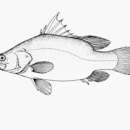en
names in breadcrumbs


Perception Channels: tactile ; chemical
IUCN Red List of Threatened Species: least concern
The growth of the Nile perch is very fast during the first year. The rate then decreases during the second, third, fourth and fifth years.
The introduction of the Nile Perch to Lake Victoria has caused serious ecological problems. The richness and diversity of endemic cichlid species is rapidly declining. Over 300 native species have already been driven to extinction due to the feeding patterns of the Nile perch (Schofield, 1999). Although for the time being the strong increase of L. niloticus seems to be a favorable development for the fishing industry, the final consequences may be very serious for future fish production in the lake (Goudswaard and Witte, 1984). Since the increase of Nile perch, the accelerated decline in diversity has altered the food web structure and caused ecological changes due largely to human actions, which have profound socioeconomic effects (Kitchell and Schindler, 1997). The continuing degradation of Lake Victoria's ecological functions has serious long-term consequences for the ecosystem services it provides and may threaten social welfare in the different countries bordering its shores (Verschuren and Johnson, 2002). Also since the increase of Nile perch, smaller scale fishing companies have been hurt significantly.
The Nile perch has yielded an increase in total fishery, and fishery-related employment has increased dramatically. Since the increase of Nile perch, larger factory fishing companies have thrived greatly.
Positive Impacts: food
The Nile perch acts as a major predator in its native and introduced habitats.
Nile perch have been observed with several different kinds of parasites, Lernea (region after the operculum), arguilids (in the gills), and various nematodes (throughout the body).
The diet of Nile perch consists of fishes, insects, crustacea and mollusks. The type of prey ingested by the predator depends on the predator size, prey availability and abundance within a given habitat (Ogari, 1984). Juvenile Nile perch feed on copepods, prawns in the genus Caridina, fish fry, small gastropods, and bivalves. As the fish matures and moves to greater depths haplochromine cichlids constitute over 95% of their food consumption. Occasional items found in the Nile perch's diet include smaller fish in the genera Barbus, Clarias, Haplochromis, Lates, Oreichromis, and Xenoclarias. Besides crustacean zooplankton, invertebrate prey includes snails, clams, and insects (odonate larvae, aquatic Hemiptera, mayflies in the genus Povilla, and larvae of phantom midges (Chaoborus). Fish in the genus Rastrineobola are very common in the diet in terms of occurrence, and are second to haplochromines (Acere, 1985). As Nile perch grow larger, they take larger prey. Nile perch less than 80 cm tend to feed on smaller fishes than those greater than 80 cm. This demonstrates that the predator is capable of shifting to other sizes of prey when more suitable sizes become scarce (Ogutu-Ohwayo, 1984).
Animal Foods: fish; insects; mollusks; aquatic crustaceans; zooplankton
Primary Diet: carnivore (Piscivore )
Lates niloticus (Nile perch) is widespread throughout the Ethiopian Region of Africa, occurring commonly in all major river basins including Nile, Chad, Niger, Senegal and Volta. The nilotic population penetrates northwards well into the geographical limits of the Mediterranean Region and is present in the waters of Lake Mariout situated in the Nile Delta. Southwards the distribution includes parts of the Congo Basin. The most common place to find the Nile perch is in Lake Victoria where the species was introduced in 1962.
Biogeographic Regions: nearctic (Introduced ); ethiopian (Introduced , Native )
Nile perch are found in many different types of fresh water. They prefer warm, tropical waters (27°N – 7°S) where they grow to large sizes and occur in high densities. Adult Nile perch occupy all habitats in lakes and rivers (10-60 m in depth) where there is enough oxygen with the exception of rocks, swamps, and the pelagic zone. Small juveniles are restricted to shallow near-shore environments (Luna, 2002; Queensland Government, 2002).
Range depth: 0 to 60 m.
Habitat Regions: tropical ; freshwater
Aquatic Biomes: lakes and ponds; rivers and streams
Wetlands: marsh
Nile perch live up to the age of 16 years. There is a higher mortality rate for males than females.
Typical lifespan
Status: wild: 16 (high) years.
Average lifespan
Status: captivity: 7.8 years.
Nile perch are silver in color with a blue tinge. They have a distinctive dark black eye with a bright yellow outer ring. Nile perch are usually seen around 2-4 kg, but have been caught and seen at sizes up to 200 kg (the largest at 232 kg). They average around 85-100 cm but can grow to 193 cm. The females are generally larger than males. The preopercle and pre-orbital bones are armed with spines, with a large spine on the free edge of the operculum.
Range mass: 232 (high) kg.
Average mass: 2-4 kg.
Range length: 193 (high) cm.
Average length: 85-100 cm.
Other Physical Features: ectothermic ; heterothermic ; bilateral symmetry
Sexual Dimorphism: female larger
Nile perch are sexually dimorphic. The male has only anal and urogential openings just anterior to the anal fin, whereas the female has a genital orifice separate from the urinary opening. They become sexually mature at the age of 3 years. Males dominate the sex ratio up to 80 cm TL, while the females are dominate at 80 cm TL and above (Asila and Ogari, 1988). Ovulation takes place in the spring with the rising water temperature. Spawning is usually done in sheltered areas, but can also occur in open waters.
Breeding season: Breeding peaks from March to June.
Range number of offspring: 3,000,000 to 15,000,000.
Average number of offspring: 9,000,000.
Average gestation period: 20 hours.
Average age at sexual or reproductive maturity (female): 3 years.
Average age at sexual or reproductive maturity (male): 3 years.
Key Reproductive Features: iteroparous ; seasonal breeding ; gonochoric/gonochoristic/dioecious (sexes separate); sexual ; fertilization (External ); oviparous
Average age at sexual or reproductive maturity (female)
Sex: female: 912 days.
Parental Investment: no parental involvement